Painting walls is an essential part of any home improvement project. However, choosing the right paint roller can significantly affect the project’s outcome. Knowing the best paint roller for walls can be challenging with so many options available. This article will discuss the different types of paint rollers available and help you choose the best one for your next painting project.

Different Types of Paint Rollers
Nap Length
The nap of a paint roller refers to the length of the fibres on the roller cover. The right nap length will depend on the texture of the wall surface you’re painting. A 3/8-inch nap is standard for most interior walls, while a 1/2-inch nap is suitable for heavily textured walls. A shorter nap will be best for smooth surfaces and newly finished drywall, while a longer nap is better for textured surfaces, such as stucco or plaster.
Material
We should also consider the material of the paint roller cover. Synthetic materials, like polyester, nylon, or a blend of polyester and wool, which are suitable for most paint types, including oil-based and latex paints. Natural fibres like lambswool or mohair are better suited for oil-based paints. Synthetic materials are generally more affordable, durable, and easier to clean, making them the most popular choice for DIY projects.
Roller Type
Roller types can vary in size and shape, but the standard and mini roller is the most common types. The standard roller is the most commonly used type suitable for most wall surfaces. The mini roller is smaller and more compact, making it suitable for painting small areas, such as corners or trim.
Choose the Best Paint Roller

Paint Type
The type of paint being used will also influence the choice of a paint roller. Latex paints are best applied with a synthetic roller cover, while oil-based paints require a natural fibre roller cover. Using the wrong roller type can result in a poor finish or difficulty applying the paint.
Quality
The quality of the paint roller is also an important consideration. Cheaper rollers may shed fibres or not hold up well after a few uses, resulting in a lower-quality finish. A high-quality roller cover will produce a smoother finish and be more durable, but it may also be more expensive. A higher quality roller may be a better investment in the long run, as it will last longer and produce better results.
Additional Features
Some paint rollers have additional features, such as an ergonomic handle or a splatter guard. These features can make the painting process more comfortable and reduce mess. While not necessary, these features can be helpful for longer painting projects or those prone to making a mess.
In conclusion, the best paint roller for walls depends on the project’s specific needs. Consider factors such as nap length, material, roller type, paint type, roller quality, and additional features when purchasing. Painting walls can be a satisfying and rewarding DIY project with the right paint roller and technique.
Tips for Using a Paint Roller

Now that you know how to choose the best paint roller for your project, let’s review some tips for using it effectively.
- Prep the surface: Make sure the walls are clean and free of debris, dust, and loose paint. Sand any rough patches, and fill any holes or cracks before painting.
- Use a roller tray: Pour the paint into a roller tray and use the roller to distribute the paint evenly across the tray. This helps ensure that the roller is evenly coated with paint.
- Please start with the ceiling: It’s best to start painting at it and work your way down to avoid drips or splatters on finished surfaces.
- Use an “M” technique: Apply the paint to the wall in a “W” or “M” shape, then fill in the pattern with straight vertical or horizontal strokes.
- Avoid overloading the roller: Don’t use too much paint, as it can result in drips and uneven coverage. Instead, reload the roller frequently to maintain an even application.
- Roll lightly: Use light pressure when rolling the paint onto the wall. This helps prevent the roller from leaving behind any marks or streaks.
- Keep a wet edge: When using a roller, it’s important to maintain a “wet edge” to avoid creating visible lines or lap marks. Work quickly and efficiently to keep the paint fresh and wet.
By following these tips and using the best paint roller for your project, you can achieve a beautiful and professional-looking finish on your walls. Remember, painting can be a fun and rewarding DIY project, so don’t be afraid to experiment and try new techniques.
Cleaning and Storing Your Paint Roller

After you’ve finished painting, it’s important to properly clean and store your paint roller to ensure its longevity and prevent any residual paint from contaminating your next project. Here are some steps to follow:
- Remove excess paint: Use a putty knife or scraper to remove excess paint from the roller cover. Scrape the roller from the top to the bottom to avoid damaging the roller fibres.
- Rinse with water or solvent: Depending on the type of paint used, rinse the roller cover with water or solvent to remove any remaining paint. For latex paint, rinse the roller cover with warm water until the water runs clear. For oil-based paint, use a solvent such as mineral spirits or paint thinner to rinse the roller.
- Spin dry: Once the roller cover is clean, spin it dry using a roller spinner or a clean, dry towel. This will help remove excess water or solvent and ensure the roller cover dries evenly.
- Store properly: Store the roller cover in a plastic bag or wrap it in plastic to prevent dust and debris from settling on it. Store the roller in a cool, dry place that won’t be damaged or crushed.
By following these simple steps, you can ensure that your paint roller lasts for multiple uses and produces a high-quality finish each time you use it.
Conclusion
Choosing the best paint roller for walls doesn’t have to be daunting. By considering factors such as nap length, material, roller type, paint type, roller quality, and additional features, you can find the perfect roller for your project. Remember to follow proper painting techniques, clean and store your roller correctly, and have fun with your DIY project. You can transform your walls into a beautiful and inviting space with the right tools and techniques.

